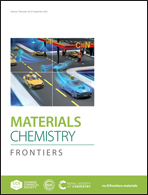In situ fabrication of fluorine-modified acrylate-based gel polymer electrolytes for lithium-metal batteries†
Abstract
Gel polymer electrolytes (GPEs) have attracted substantial interest due to their high lithium-ion conductivities and safety. However, the narrow electrochemical stability windows and poor mechanical properties of conventional GPEs limit their application in batteries targeting high energy densities. Herein, a fluorine-modified acrylate-based GPE is designed and prepared via in situ polymerization, which exhibits a wide electrochemical window, high Li+ transference number and ionic conductivity. The introduced fluorine-rich group can promote the uniform deposition of Li ions and inhibit the growth of Li dendrites, thus enabling stable cycling of Li symmetric cells for 2400 h at 0.1 mA cm−2. Meanwhile, a Li-metal cell with the NCM811 cathode and GPE exhibits promising long-term cycling stability (91% capacity retention after 260 cycles, 2C) and rate capability (e.g., 125 mA h g−1 at 10C), when cycled between 3.0 and 4.5 V at 25 °C. Moreover, this GPE is also successfully utilized in pouch cells, and 81% capacity is maintained after 150 cycles. This study demonstrates the potential of fluorination in promoting the performance of GPEs and can serve as a guideline for the future development of Li-metal batteries with high-nickel layered cathode materials.



 Please wait while we load your content...
Please wait while we load your content...